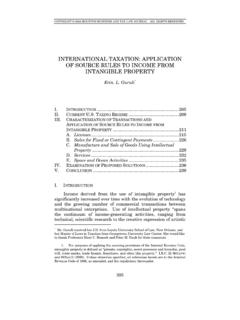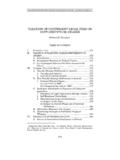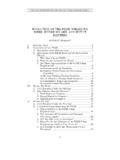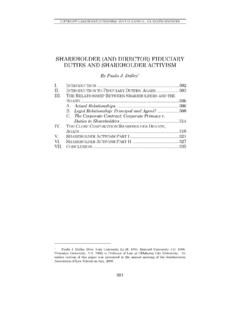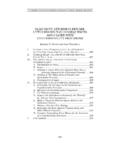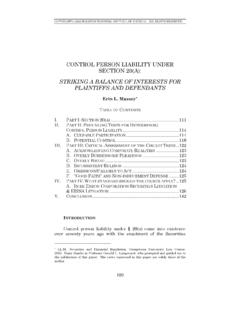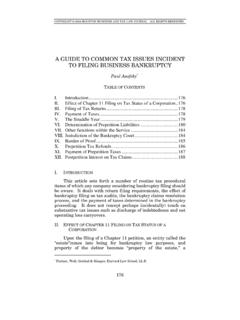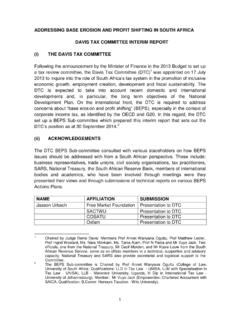Transcription of TAXATION OF PARTNERSHIPS AND PARTNERS …
1 COPYRIGHT 2002 HOUSTON BUSINESS AND TAX LAW JOURNAL. ALL RIGHTS RESERVED. 143 TAXATION OF PARTNERSHIPS AND PARTNERS ENGAGED IN INTERNATIONAL TRANSACTIONS: ISSUES IN CROSS-BORDER TRANSACTIONS IN germany AND THE Martin H. Seevers* TABLE OF CONTENTS I. 145 II. TAXATION OF PARTNERSHIPS IN THE DOMESTIC 147 A. In 147 B. The United 152 1. Character of Income .. 154 2. Timing of Pass-Through: Taxable Year .. 159 3. Reporting, Refund, and Auditing Purposes .. 160 4. Sale of partnership Interest .. 160 5. Guaranteed 162 6. Tax Withholding .. 164 C. 166 1. PARTNERSHIPS under German Civil Law .. 166 2. Basic Tax Principles: Conduit or Entity .. 167 3. partnership engaged in a Trade or Business (gewerbliche Personengesellschaft) .. 168 4. Passive Investment partnership (Verm gensverwaltende Personengesellschaft) .. 170 5. Guaranteed Payments (Sonderverg tungen) .. 170 III. TAXATION OF PARTNERSHIPS ENGAGED IN INTERNATIONAL 171 A.
2 The United 171 1. partnership or Corporation .. 172 (a) Investors participating in a Foreign Entity .. 173 * Tax Attorney (Rechtsanwalt), Deloitte & Touche GmbH, D sseldorf, germany . University of Passau, germany , First State Examination (Law Degree), 1995; State of Bavaria, germany , Second State Examination (Law Degree), 1998; University of Houston Law Center, in TAXATION , 2000. The author practices in the area of Mergers & Acquisitions, Corporate Restructurings, International Tax Law, and Cross Border Transactions. The author would like to thank Professor William Streng and Professor Ira B. Shepard for their support and assistance during his studies and with this article. The author can be contacted at COPYRIGHT 2002 HOUSTON BUSINESS AND TAX LAW JOURNAL. ALL RIGHTS RESERVED. 144 HOUSTON BUSINESS AND TAX LAW JOURNAL [Vol.]
3 II (b) Foreign Investors participating in a Entity .. 174 2. Domestic or Foreign 175 3. Domestic partner in a Domestic partnership with Foreign Income .. 176 4. Guaranteed 178 5. Domestic partner in Foreign partnership with Domestic or Foreign Income .. 179 6. Foreign Tax Credit and Classification 181 (a) treats Foreign partnership as a 182 (b) treats Foreign Corporation as a partnership .. 186 7. Foreign partner participating in or Foreign partnership .. 188 (a) Income Effectively Connected with a Trade or Business in the 190 (1) Trade or 190 (2) Effectively 191 (b) Certain Source Income not Effectively Connected with a Trade or Business .. 192 (c) Deductions, Credits, Losses and 193 (d) Guaranteed Payments .. 194 B. 196 1. Domestic partner participating in a Domestic partnership that Receives Foreign Income .. 197 2. Foreign partner participating in a Domestic partnership that Receives Domestic/Foreign Income.
4 199 3. Foreign partner Participating in a Foreign partnership that Receives Domestic/Foreign Income .. 201 4. Domestic partner participating in a Foreign partnership that Receives Foreign Income .. 202 5. Domestic partner participating in a Foreign partnership that Receives Domestic Income .. 204 IV. ENTITY 206 A. The United 206 B. 209 1. Domestic Entities .. 209 (a) Classification .. 209 (b) Overview of Business Entities in germany .. 210 2. Foreign 213 V. CLASSIFICATION CONFLICTS AND ENTITLEMENT TO TREATY 213 A. Application of Tax Treaties to PARTNERSHIPS : In 213 B. Corresponding Classification of PARTNERSHIPS by Contracting 215 C. Non-Corresponding Classification by Contracting States (Classification Conflict).. 217 COPYRIGHT 2002 HOUSTON BUSINESS AND TAX LAW JOURNAL. ALL RIGHTS RESERVED. 2002] TAXATION OF PARTNERSHIPS 145 1. partnership s Country of Residence treats partnership as Entity (Fiscally Intransparent) .. 217 2.
5 partnership s Country of Residence Treats partnership as Fiscally Transparent .. 222 3. Innovative Approach under the Model Treaty and 223 D. Guaranteed 225 VI. 230 I. INTRODUCTION This study examines basic issues in the TAXATION of PARTNERS and PARTNERSHIPS engaged in international transactions. Special consideration is given to the tax consequences resulting from the use of PARTNERSHIPS in cross-border transactions between the United States and germany , the entitlement of PARTNERSHIPS to treaty benefits, and classification conflicts. One of the effects of a rapidly growing global marketplace is an increased use of the partnership form in international business Although PARTNERSHIPS have always played a major role as business entities in the and germany , the corporate form has traditionally been the prevailing entity choice in international investment activities, partly because the limitation of personal liability is always a major planning 1.
6 See, , NEWS CORPORATION, BUSINESS OVERVIEW 1997, CHAIRMAN S MESSAGE, available at (last visited Feb. 16, 2002) (attributing the company s financial success to its increased use of PARTNERSHIPS which minimized the company s capital exposure while increasing its presence in the global media marketplace); Paul O Shea, A Year to Remember 3 Cheers for a Bright New Year, available at (last visited Feb. 15, 2002) (reporting that some pundits have observed that alliances and PARTNERSHIPS [in the analog industry] are becoming more popular than mergers and acquisitions for improving productivity ). 2. See ERNST & YOUNG, DOING BUSINESS IN THE UNITED STATES 23, 27 28 (1999) [hereinafter DOING BUSINESS IN THE ] (stating that [i]n the United States, most large businesses operate as corporations; [d]omestic investors often decide to operate in corporate form to obtain the benefit of limited liability; and [f]oreign corporations often operate in the United States through a separately incorporated subsidiary rather than through a branch, primarily to minimize their potential liability exposure ); ERNST & YOUNG, DOING BUSINESS IN germany 30, 31 (1996) [hereinafter DOING BUSINESS IN germany ] (explaining that, in regards to domestic entities, large operations are usually conducted through stock corporations or GmbHs, medium-size and family-owned businesses are often run through a GmbH & Co.)
7 KG because of the advantages afforded from limited liability, whereas [f]oreign investors usually operate through corporate subsidiaries or German branches generally because of the tax advantages); URBACH HACKER YOUNG INTERNATIONAL, DOING BUSINESS IN germany 8 (2002), available at (stating that: Numerous forms of organisation and structure are available to foreigners setting up businesses in germany . German Commercial Law COPYRIGHT 2002 HOUSTON BUSINESS AND TAX LAW JOURNAL. ALL RIGHTS RESERVED. 146 HOUSTON BUSINESS AND TAX LAW JOURNAL [Vol. II However, many countries, such as the and germany , have adopted partnership forms that combine the benefits of limited liability with a pass-through 3 tax As a result, PARTNERSHIPS are becoming increasingly popular in both domestic and international Even though PARTNERSHIPS offer far greater flexibility and planning opportunities than corporations, the TAXATION of PARTNERSHIPS engaged in international activities is still afflicted with uncertainty.]
8 A major concern is the application of tax treaties to PARTNERSHIPS and whether PARTNERSHIPS are entitled to treaty benefits. The problem becomes even more complex if the contracting states differ in their tax treatment of PARTNERSHIPS . distinguishes between unincorporated firms and corporations. The legal structure depends crucially on the degree of liability to creditors. A corporation is a legal entity in itself and is, hence, only liable to the extent of its capital contribution. In the case of the unincorporated company, at least one of the PARTNERS has unlimited liability of the firm s debts.). 3. See Joel Rabinovitz & Eric. M. Zolt, Tax Nothings, in TAX STRATEGIES FOR CORPORATE ACQUISITIONS, DISPOSITIONS, SPIN-OFFS, JOINT VENTURES, FINANCINGS, REORGANIZATIONS & RESTRUCTURINGS 1999, at 181, 190 (PLI Tax Law and Estate Planning Course, Handbook Series No.
9 J0-001E, 1999), available at WL 449 PLI/TAX 181 (describing a partnership as a pass through entity, which means that tax consequences are taxed to the PARTNERS instead of taxing the partnership directly at the entity level); see also 701 (1994) (prescribing in pertinent part that [a] partnership as such shall not be subject to the income tax imposed by this chapter ). 4. See J. William Callison, Venture Capital and Corporate Governance: Evolving the Limited Liability Company to Finance the Entrepreneurial Business, 26 J. CORP. L. 97 (2000) (noting that limited liability PARTNERSHIPS (LLPs), which are recognized in all fifty states, provide liability protection to general PARTNERS ); see also UNIF. P SHIP ACT 306(c) (1997), WESTLAW [hereinafter UPA] (prescribing that [a]n obligation of a partnership incurred while the partnership is a limited liability partnership , whether arising in contract, tort, or otherwise, is solely the obligation of the partnership and that [a] partner is not personally liable, directly or indirectly, by way of contribution or otherwise, for such an obligation solely by reason of being or so acting as a partner ); UNIF.
10 LTD. P SHIP ACT 303 (2001), WESTLAW [hereinafter ULPA]. In germany , the Kommanditgesellshcaft ( KG ) is a limited partnership -type form similar to the limited PARTNERSHIPS in the See 161(1) Handelsgesetzbuch (Commercial Code) [hereinafter HGB]; see also infra notes 109, 388 and accompanying text. 5. See, , Alex Y. Seita, Globalization and the Convergence of Values, 30 CORNELL INT L 429, 443 (1997) (stating that businesses in expanding markets set up PARTNERSHIPS with foreign firms, to share technology and risk, in order to create new products ); Colin Ives, Results from our Latest Survey (Mar. 2001), available at (reporting that [i]nterest in the introduction of Limited Liability PARTNERSHIPS in the UK continues to grow with 89% of firms considering limiting liability saying it was likely or possible that they would consider becoming a Limited Liability partnership in the near future); Fred Reish & Bruce Ashton, R&L Erisa Audit Report (Oct.)
